At the Challengers, More Middling Than Movie Magic
A trip to Charlottesville shows Hollywood changed little about life on the middle rungs of the tennis ladder.
Reporting on the road for Bounces for the first time…
CHARLOTTESVILLE, Va. — There’s a decades-old phenomenon of cinetourism: being featured on the silver screen is a great way to put an obscure place on the map of public consciousness, drawing the masses to flock to the scenery they’ve seen on screen in person.
THE MAN WITH THE GOLDEN GUN (1975) made Khao Phing Kan in Thailand so popular that it’s now most commonly called James Bond Island; similarly, it wasn’t until INDIANA JONES AND THE LAST CRUSADE (1989) that the ancient wonder of Petra, Jordan was boosted into being a major global tourist attraction.
For all the successes of CHALLENGERS (2024)—the critically-acclaimed, zesty and zeitgeisty film about drama on the middle rungs of professional tennis that is still inspiring viral Halloween costumes six months after its release—…
…cinetourism was has not been one of them. In the months since the movie’s release, there’s been no bump in prominence or prestige at the Challenger Tour; little has changed for those on the ground in the lower-middle class of men’s tennis.
Having just spent a few days back down at the Challenger Tour this week, it became clear why: a Challenger, by design, just doesn’t feel like a destination. A Challenger is a liminal space. A Challenger is a purgatory. A Challenger is The Medium Place, albeit with a population far more numerous than just Mindy St. Claire.
A Challenger has its satisfactions and rewards, but also its meticulously offsetting frustrations and costs. A Challenger is a thoroughly zero-sum place to be, and a fascinating place to do the math about everything that goes into the equation of tennis.
The Challenger Roadmap
Challengers are both nowhere and everywhere. There are 208 Challenger-level tournaments on the 2024 ATP Calendar; that’s more than triple the 68 events that make up the top-flight of tour-level tournaments this year (the four majors, the Olympics, the year-end ATP Finals, nine Masters 1000s, thirteen 500s, and thirty-eight 250s).
Challengers are the middle flight of sanctioned professional men’s tennis, below the ATP Tour but above the entry-level ITF Men’s World Tennis Tour (also called, optimistically, the “Futures”). Players at the Challenger level are usually ranked roughly between 80th and 300th, meaning there’s a mix of players who are and aren’t breaking even on their tennis pursuits.
I dropped into this tier this week at the Charlottesville Challenger. The indoor tournament in Charlottesville, fittingly, is on the middlest tier of this middle tier, offering $75,000 in prize money to its field (less than the $100,000 in Seoul this week, but more than the $50,000 in Brazzaville).
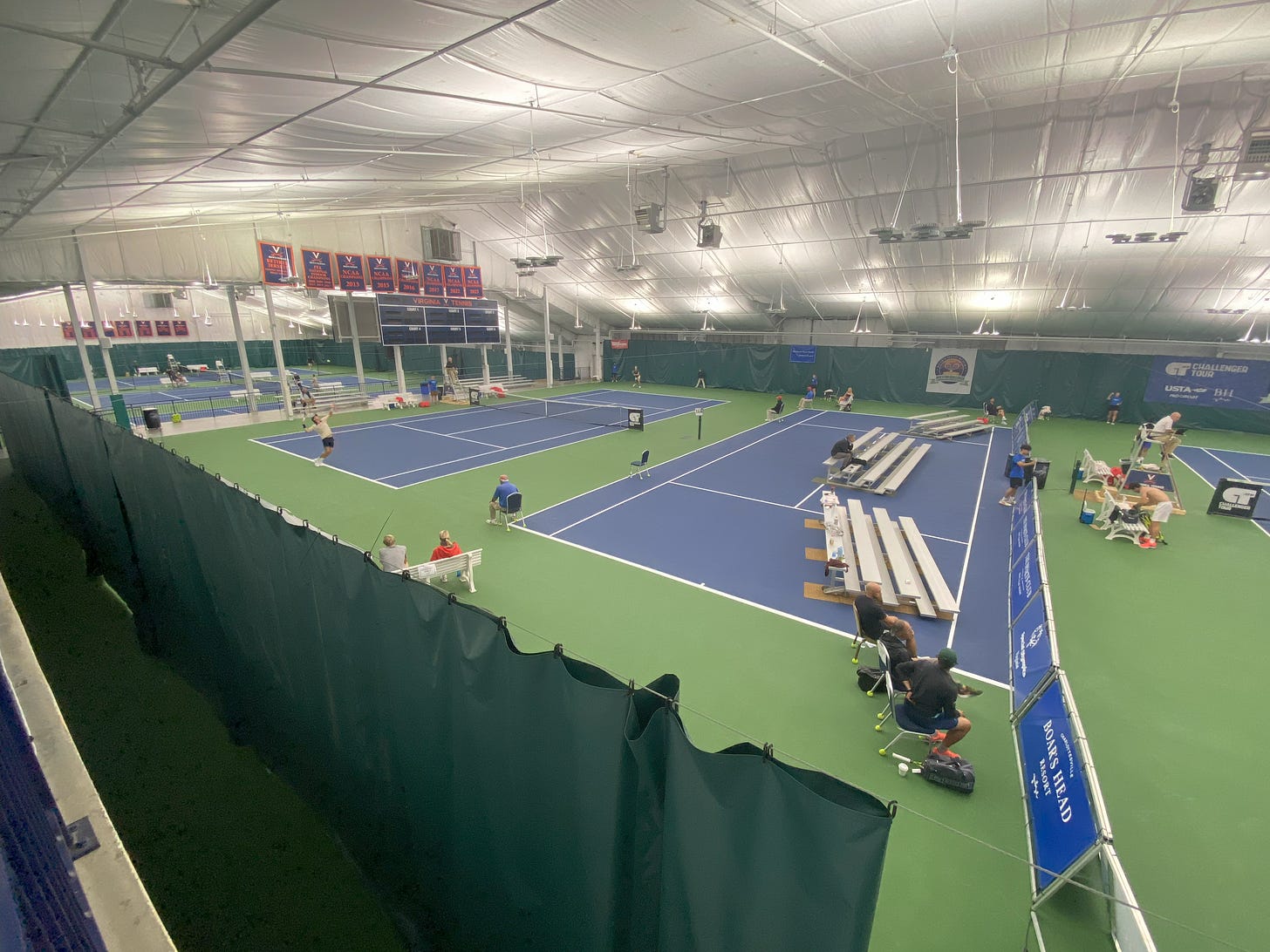
Perhaps fittingly for their transitional status, Challengers tend to be located between major urban areas, in small-to-medium sized cities like Charlottesville. These locales are often without major airports, so getting there takes some effort. Most of the two-and-a-half-hour drive from my hometown of Washington, DC to Charlottesville in central Virginia isn’t on interstates, and thus requires constant consciousness of the frequently fluctuating speed limit to avoid being snared by the deputies staked out at speed traps in each successive county; if you miss one of the many arbitrary switches from 60 mph to 45 mph, you’re toast.
It’s similarly impossible to sustain a comfortable cruising altitude on this part of the tennis map; everyone at Challengers always seems to be either gaining or losing speed, spurting or sputtering. Occasionally, a rare talent will soar and reach an exit velocity that launches him to the next level; more frequently, the Challengers are where a shooting star crash lands.
The Cast in Charlottesville
The player field in Charlottesville featured a typical cross-cut of the layers of the Challenger terrain, ranging from players who would be recognizable to any knowledgeable tennis fan to guys who don’t yet have their own Wikipedia entries.
Familiar names were there starting from the Charlottesville qualifying draw. Kyle Edmund was considered the future of British tennis when reached the semifinals of the Australian Open and a career-high ranking of No. 14 in 2018. But Edmund hasn’t been able to regain the form he had before a left knee injury in 2020, leaving him nearly forgotten in the British tennis conversation. When he came back to the ATP Tour in 2022 using the protected ranking that let him compete in ten tour-level events, he won just two matches in those ten tries. Edmund has been moving upward this year, though more slowly than would probably be tolerable for someone of his pedigree, bumping his ranking from 538th to his current spot of 350th. After winning two matches in qualifying in Charlottesville, Edmund lost in the first round of the main draw.
Another former top-20 player, Bernard Tomic, is also on an almost imperceptibly incremental upward slope. Climbing from 289th to 207th could be considered a successful season for a 19-year-old; for a 32-year-old, it’s tougher to be satisfied. Tomic climbs no further this week: he lost his first round match in Charlottesville in an hour.
Edmund and Tomic both lost to opponents who are currently ranked higher than them, but even former top players who are still ahead on paper can find themselves rudderless in the fugue of a Challenger.
Reilly Opelka, who was at his career-high ranking of No. 17 when forced off the tour in 2022 by a series of hip and wrist issues, has made pretty quick progress this year, climbing from 1187th to 295th. But the emotionally beige courts at Challengers seem to neutralize many of natural advantages in both talent and experience: playing his second round match in front of a countable crowd of 53 spectators on Wednesday evening was a far cry for Opelka from playing against Rafael Nadal in a packed stadium in Indian Wells, and his aura seemed dulled. Though he still was dressing his part as an unlikely artworld darling—matching his still omnipresent pink tote bag to his pink hat and pink sneakers—Opelka couldn’t seem to generate any buzz in the vacuum.
Once his opponent, 390th-ranked Colton Smith, started to gain an advantage near the end of the match, Opelka made his displeasure clear. When Smith said “come on” after a pair of Opelka unforced errors late in the third set, Opelka mockingly growled back his own “come on”s on each of the next four points. Opelka’s bark was worse than his bite, in the end, and he lost 6-7(5), 6-4, 6-4.
The starkest loss from a big American in Charlottesville came one day before Opelka’s. Christopher Eubanks had slingshotted himself up the rankings last summer, better than halving his ranking from 77th to 32nd when he won nine straight matches on grass, winning an ATP 250 title in Mallorca and then beating Stefanos Tsitsipas to reach the last eight at Wimbledon (Eubanks nearly reached the Wimbledon semifinals, too, leading Daniil Medvedev two sets to one in their quarterfinal).
But after his ranking crested at 29th last August, it’s come crashing down even more steeply than it rose: in a stretch from February to June Eubanks lost 12 of 13 matches; when Eubanks then lost in the first rounds of Mallorca and Wimbledon, he plummeted from 42nd to 128th.
Eubanks has sustained his visibility in the sport through his work for ESPN at this year’s U.S. Open, but once he put down the microphone and picked up his racquet this fall, it was to sojourn through the Challenger circuit.
Ranked 119th, Eubanks was the top seed in Charlottesville, and he faced one of the lowest-ranked possible opponents in the first round: 600th-ranked Patrick Zahraj. Zahraj had won two third set tiebreaks to make it through qualifying, including surviving the end of his second match with forehand slices after smashing his right thumb into a courtside pillar—“on the one tiny section of it which wasn't cushioned,” Zahraj later told me.
When an X-ray showed that he only had a bone bruise, Zahraj decided to stay in the tournament. Improbably, he kept winning: Zahraj raced to an early lead over a badly misfiring Eubanks, and took the first set 6-1. After Eubanks failed to convert either of his two set points in the second set tiebreak, he dumped a forehand into the net on Zahraj’s first match point, ending the 6-1, 7-6(7) loss.
The nadir for Eubanks was a peak for Zahraj’s professional career, though a day later he acknowledged it wouldn’t get him very far on its own. “Feels good, of course,” Zahraj told me. “But it's just one round and it's just six more points, which is like 20-30 spots in the ranking, which is not much, right?”
Patrick Zahraj—whose name is remarkably close to that of Challengers character Patrick Zweig—is a 25-year-old Type 1 diabetic from Germany who played collegiate tennis for UCLA. Zahraj told me he had given himself a year after graduation to try to reach the Top 500. He didn’t quite reach that goal, and saw some of his peers leaving him in the dust. “You see guys you’ve competed with in college making those bigger jumps, maybe winning a tournament here and there,” he told me.
But despite his lack of a breakthrough, Zahraj said he wasn’t ready to quit just yet. He’s sticking with tennis for now, though he knows what will come next whenever he stops: a Master’s degree in finance. “It’s always an opportunity cost when you’re playing tennis, right?” he told me. “It’s not like you can build your resume with with internships or jobs or whatever.”
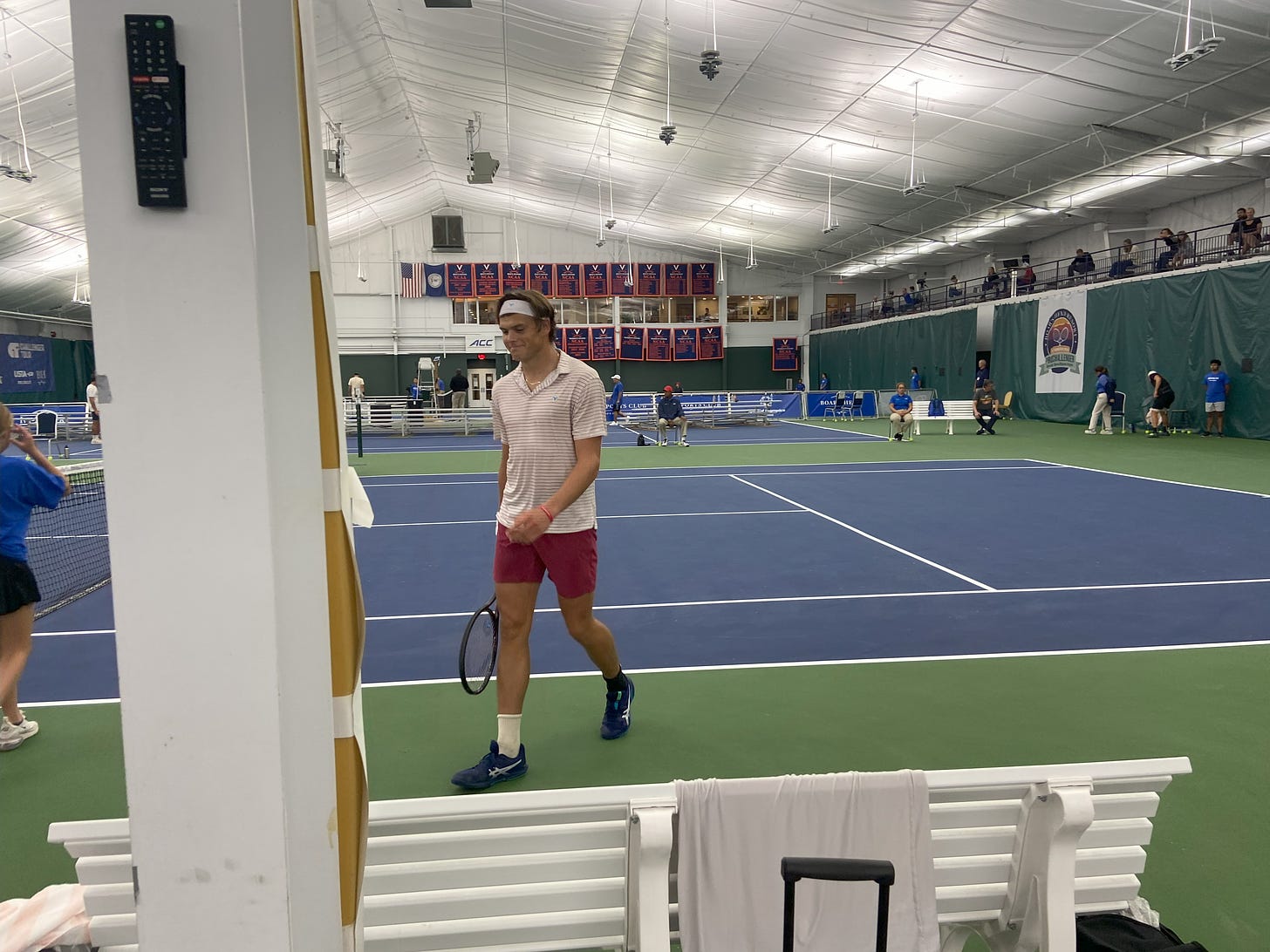
His financial acumen has already been necessary even before that career formally begins. Zahraj, who has earned only $6,017 in prize money this year, had a few private sponsors from his hometown withdraw their support when Germany entered a recession, which has meant he hasn’t been able to pay a coach. But he has been able to keep himself afloat by playing club matches over the summer and looking for brand deals and modeling work. His website lists the dates his current contracts expire, in case any prospective sponsors might be looking. “You kind of have to,” Zahraj said of leaving himself open to other earning possibilities. “It’s going to make it easier to survive. You have to find solutions.”
Zahraj’s solutions on court ran out in the second round in Charlottesville, quickly losing 6-2, 6-0 to Nishesh Basavareddy.
Making It Out
Basavareddy, a 19-year-old Stanford standout who has soared from 1,114th to 197th in the past year, was one of the few players in Charlottesville who seems on his way up and out of the Challenger-tour limbo. With strong results down the stretch, Basavareddy could even sneak into the field of this year’s NextGen ATP Finals event in Jeddah.
Another player in Charlottesville, 18-year-old Learner Tien of California, is currently in a qualifying position for Jeddah. Tien won three Challenger tournaments already this year, posting a 56-9 record as he climbs from 473rd to 125th. He made that rise despite being sidelined for a couple months by a “slight fracture” in his one of his left ribs. “The past couple months have been a lot better than I ever could have imagined earlier this year,” Tien told me.
Tien said that level-headedness had been a key to managing matches and tournaments amid the “dips and spikes” of the Challenger level. “The tour is always the main goal,” he said. “I'm not trying to rush myself out or give myself a deadline of a time that I have to be out, or put too many expectations on myself. But yeah, that is obviously the goal, to get out eventually.”
Tien, who got a main draw wild card into the U.S. Open the last three years, is one of the players in Charlottesville who has tasted the biggest stages of the sport.
Tien’s quarterfinal opponent in Charlottesville, Estonia’s Mark Lajal, recently played on the biggest stage of all, facing defending champion Carlos Alcaraz on Centre Court in the first round of Wimbledon four months ago.
Lajal acquitted himself well against Alcaraz in a 7-6(3), 7-5, 6-2 loss, and gained attention for his dreadlocked blond updo. But instead of proving himself against a top star becoming an immediate launching pad, Lajal told me the experience was tough to move past. “It was a bit difficult coming out of it,” Lajal told me. “I had done a good match and I felt like I wanted to keep the thing going, but I kind of never really got over the fact that I played there. At the next couple of tournaments, I was kind of still thinking about Wimbledon. Everyone’s talking to me about Wimbledon. So I wasn’t really focused on the matches that were coming; I was more focused on the match that I played.”
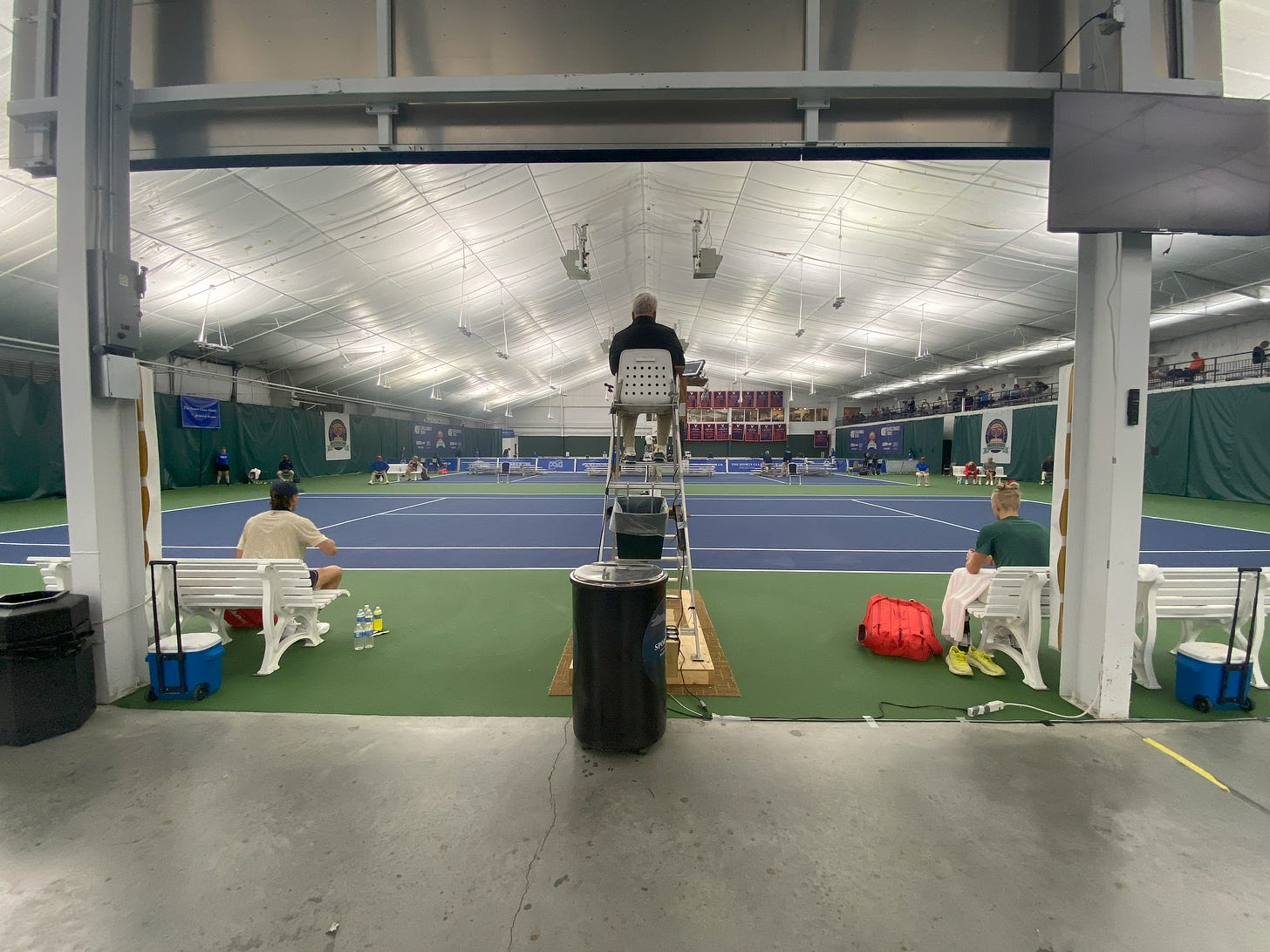
Lajal, who is projected to be ranked 227th after reaching the quarterfinals in Charlottesville, will be on the bubble for making it into Australian Open qualifying in a couple months. He said the biggest difference between Alcaraz and the opponents he faces at Challengers is their ability to play their best when stakes are highest. “The biggest difference I felt was on the important moments: he just raised his level,” Lajal said of Alcaraz. “On the big moments he just played better, played big, and played smart. And I think that's the biggest difference between him and the players here.”
Challenger Compliments, Complaints, and Comments
The Charlottesville Challenger keeps its place in the middle with an equilibrium of pros and cons, which players, coaches, and anyone else around will readily enumerate.
What’s Good:
That Challenger matches are streamed, including in a high-quality multi-camera production on the main court, is a considerable perk for players who have often spent years hitting great shots that no one saw. “Fun to have it on camera,” Zahraj said of a point against Eubanks in which he hit two tweeners. Many Challengers in the U.S., including Charlottesville, are also enhanced with play-by-play commentary by beloved broadcaster Mike Cation, which adds to the players feeling like they’ve made it as professionals.
Many of the essential tennis basics, Lajal told me, are also reassuringly reliable here.
“One of the reasons why I come to the U.S. is because you know what you’re going to get,” Lajal said. “You’re going to get a good hotel, you’re going to get good courts, you’re going to get good balls. In Europe you can go from one week being really nice and the next week going to a bit of a...not a ‘shithole,’ but, you know, the hotel is kind of kind of weird and stuff.”
What’s Not Good:
The millions upon millions of dollars the USTA makes from the U.S. Open are not trickling down to places like Charlottesville as robustly as nearly anyone would like, which can lead to shortfalls that affect matches. Within minutes of arriving to the tournament in Charlottesville, I was asked if I had any interest in being a ball kid for an hour or so1; there would a complete lack of ball kids on the premises for the next several hours, I was told, and match play was slowing down as a result.
The quality of officiating is the more constant complaint at Challengers. With the top-flight tournaments switching away from line judges in favor of automation, fewer people are signing up to be officials, and tournaments like Charlottesville are operating with fewer—and less competent—officials as a result. Because of the shortage in Charlottesville, match play was limited to just two courts at a time.
Lajal said he wanted electronic line calling to be the budget priority at the Challenger level going forward. “There's a lot of times where you can lose a couple of important moments just because of a bad call,” Lajal said, “and that doesn't happen in the ATP Tour.”
There was also one strange moment in Charlottesville about the professionalism of a camera operator who was moving around frantically during play; after winning a first round match, one victor accusingly asked the cameraman if he had betting on the match, convinced that his erratic movements had to have been intentionally trying to distract him.
Downgraded and Devalued:
One of the biggest talking points at the Challengers this year has been how their ranking point offerings have been diminished, making it harder to break out of this orbit into the next one. While points at other tiers stayed fixed, the ATP lowered ranking points at the Challenger level this year for all finishers except the champion.

Winning just one main draw match at an ATP 250 earns a player 25 points; to exceed that at a $75,000 Challenger like Charlottesville now requires being one of the two players to reach the final. When guys on the ATP Tour can maintain their altitude with an occasional first round win while Challenger tour consistency isn’t rewarded, it makes this middle tier more of a morass than it used to be.
It’s even starker for guys trying to make it up the doubles ladder. The American pairing of Ryan Seggerman and Patrik Trhac have won seven Challenger doubles titles together this season, but it’s only been enough to get them respectively up to 77th and 82nd in the ATP doubles rankings, which might not be enough to make it into the draw for the Australian Open.2
Small Time Charms
Where Charlottesville falls below the middle range of the Challenger Tour is in attendance: with crowd sizes not exceeding double digits at any time I was there this week, Charlottesville is in the low end of the Challenger spectrum, particularly compared to some of the concurrent indoor events in Europe that can feel closer to 250-level events.
The upside of this is that attending Charlottesville is remarkably intimate and immersive. For media and fans alike, mixing and mingling with players is constant and easy, which was a refreshing change from the increasingly segregated spaces of ATP Tour events.
Being around the players in Charlottesville as they sat around, ate, and watched matches was hugely illuminating. By osmosis, it was easy to learn what topics are currently interesting them—hotel options next week in Knoxville, Zyns, ramen options, Wordle strategy—and which aren’t: despite being less than a week away, I didn’t hear one single player discussing the election.
Not Like the Movies
While Trump and Harris didn’t seem to be making any impact on the players, nor did Luca Guadagnino, Zendaya, Josh O’Connor, or Mike Faist.3 Nothing about the Challenger tour seemed any steamier or more cinematic after its Hollywood moment, and nor was there any apparent increase in interest from the local public. And nor, of course, did the Challenger tour take on any qualities of the movie: if there was any knife-edge psychosexual homoerotic tension among the players on or off court in Charlottesville, I missed it.
Even among those who make their lives on the Challenger tour, many of them haven’t seen the movie. Mark Lajal was one of the ones who said he had seen the movie, calling it “a bit funny.”
“I think it was the way it was depicted was a little bit weird,” Lajal told me. “I mean, it was entertaining, but as a tennis player you see all the little things, the techniques—it was so off. It was fun to watch, but I hope that people don't think that the life's like that on tour.”
I regret not saying yes quickly and enthusiastically enough to make this ball kid experience happen, alas.
Their combined ranking for the entry list would be 159; last year the Australian Open men’s doubles cut was at 140. It’s also worth noting that Seggerman/Trhac haven’t helped their cause by not taking their chances when they’ve had them at tour-level this year, going 1-4 at tour-level events.
There was, however, a rumor in Charlottesville that Zendaya and Tom Holland did recently attend the Tiburon Challenger without anyone noticing.





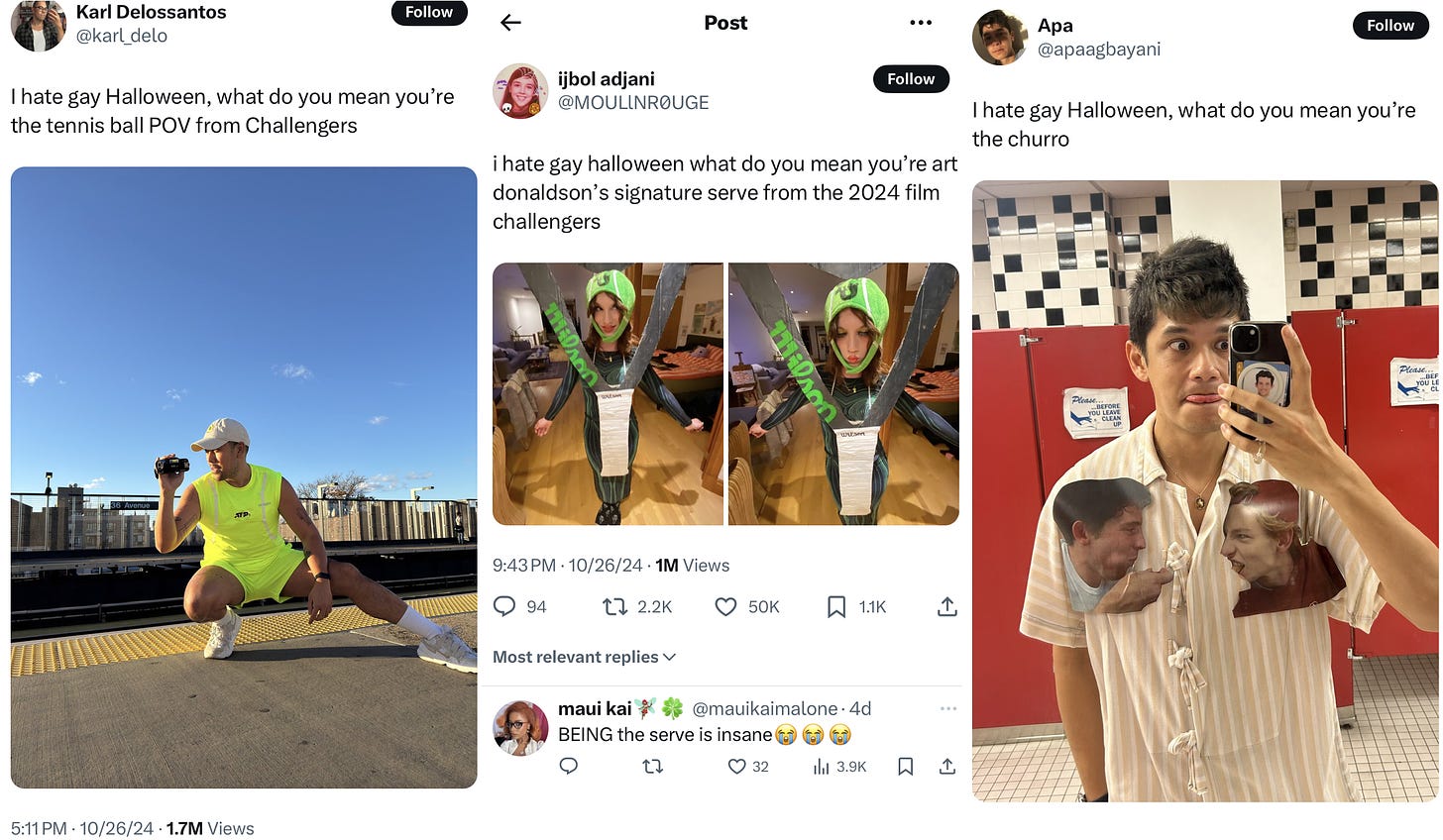
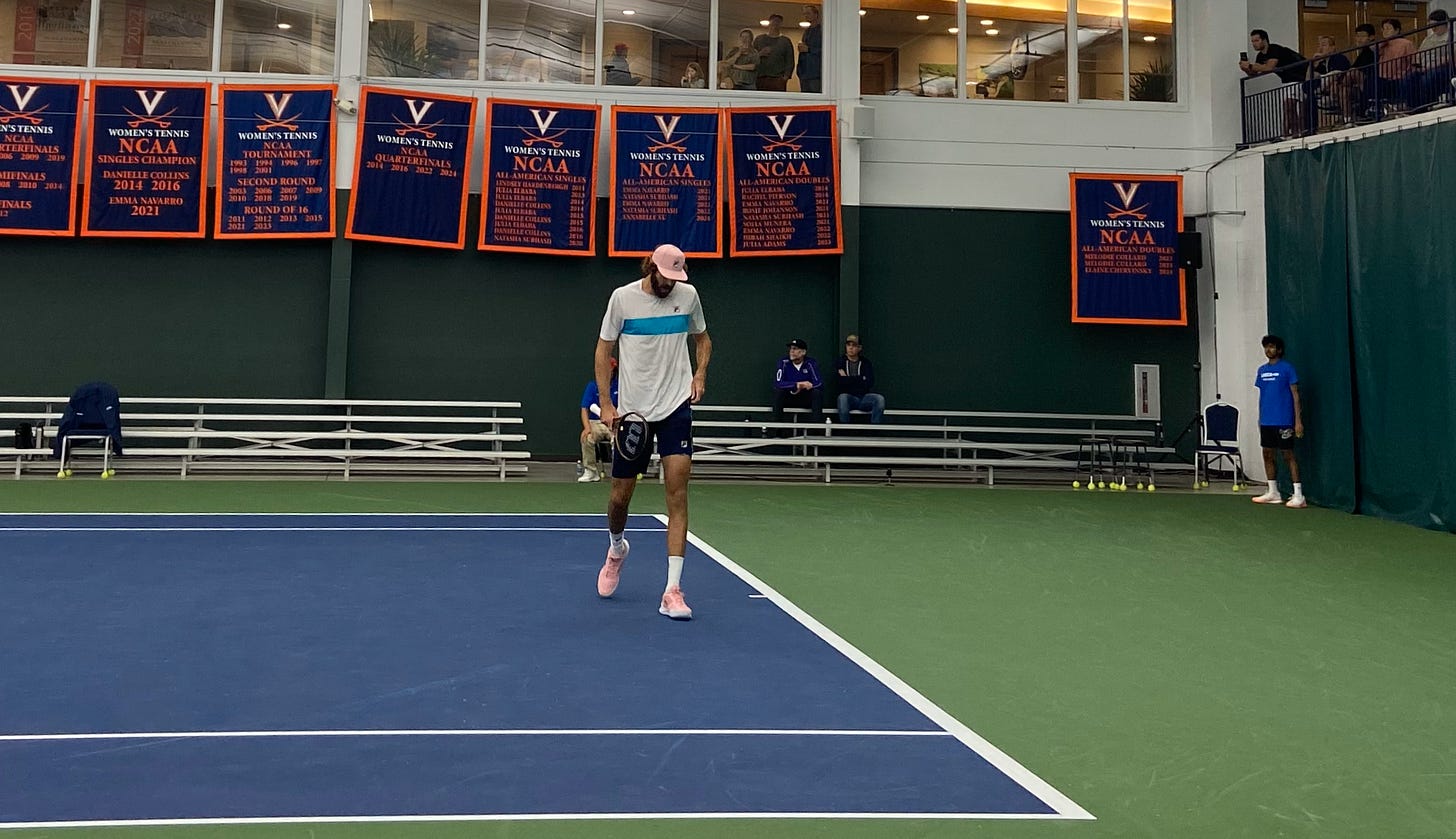
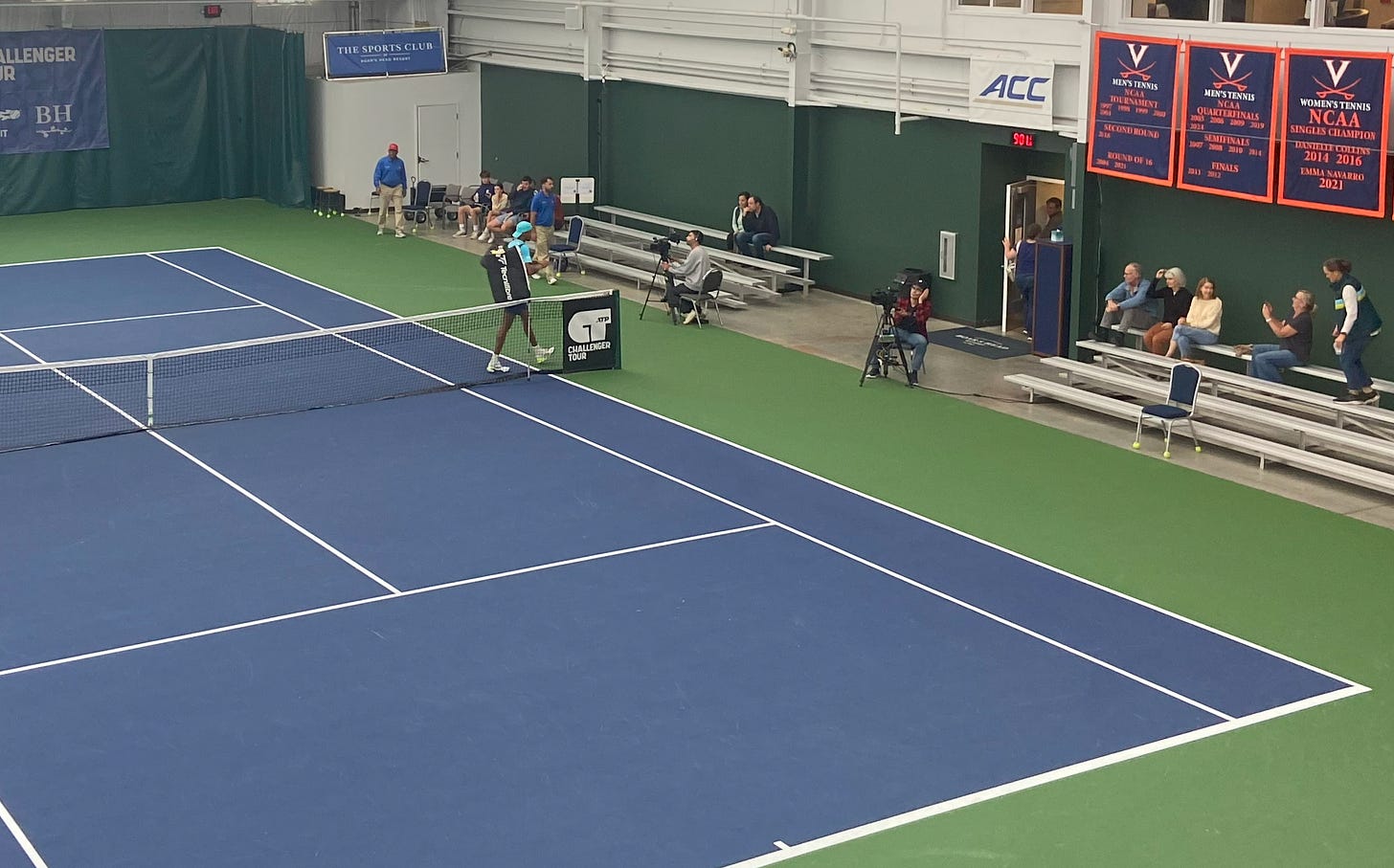
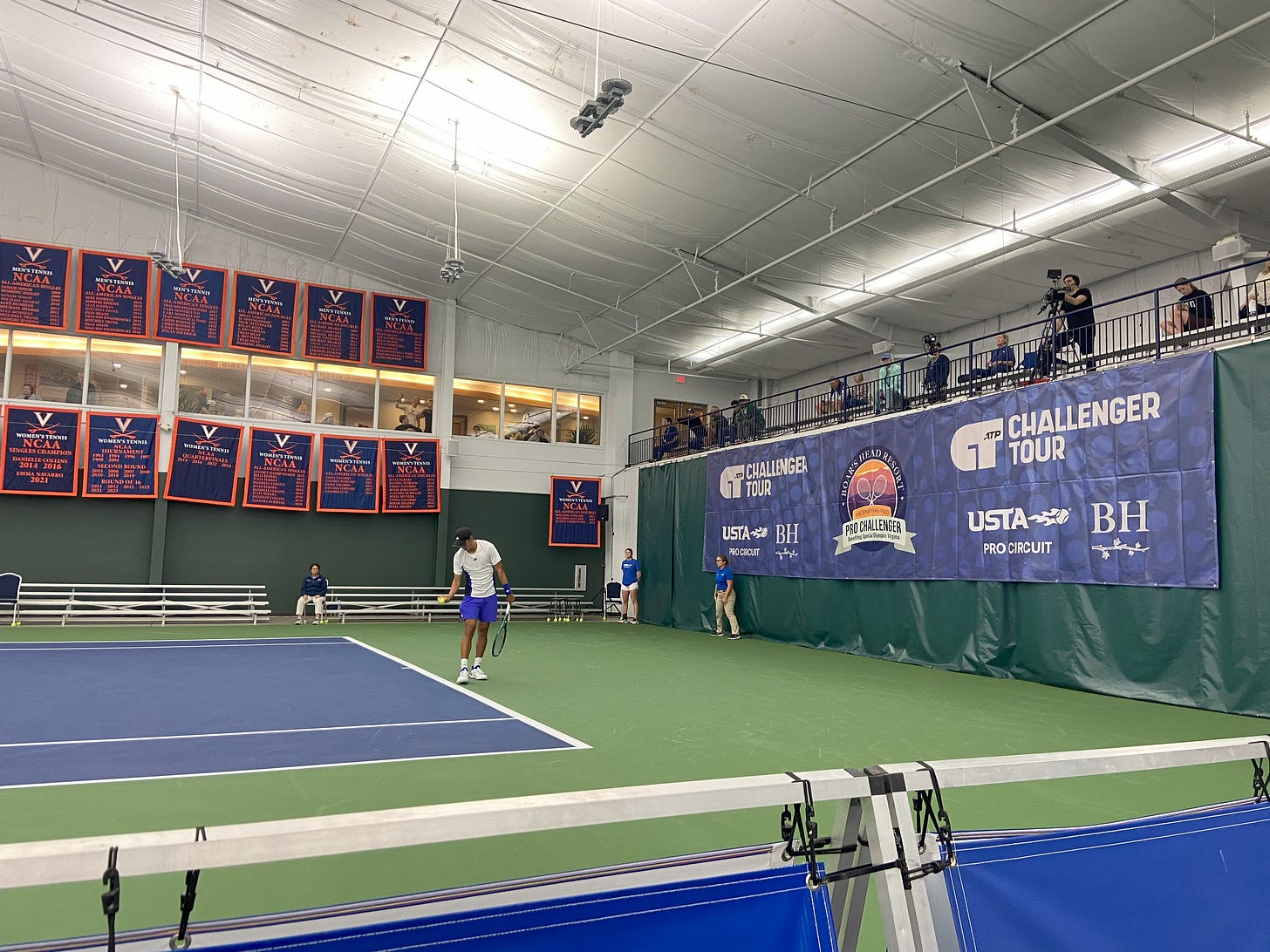
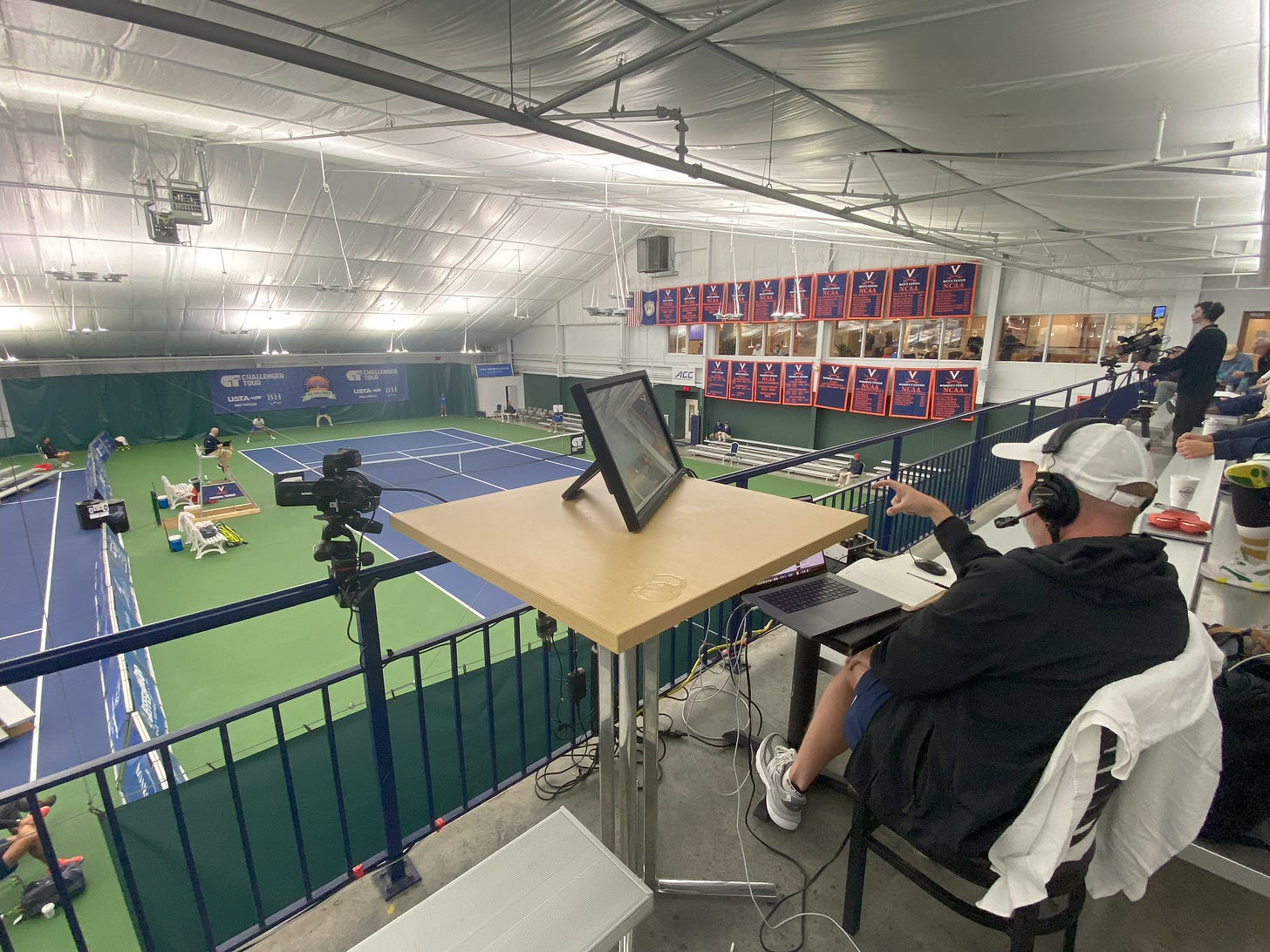
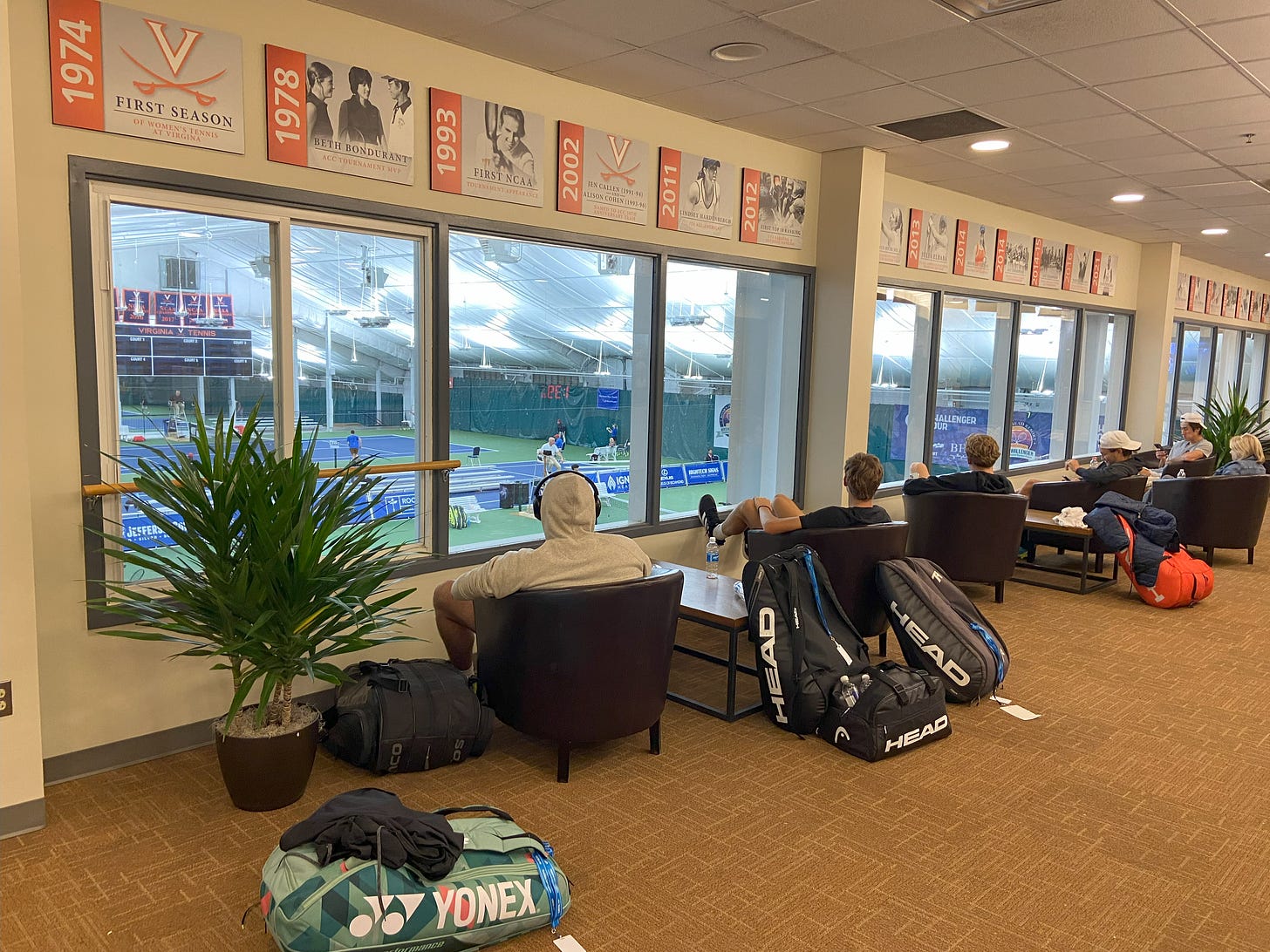
Excellent piece! Well-done. Unforced error on the no-ballboying, though.
Great reporting! I actually drove down from Richmond on the same day + it was my first time seeing tennis on this level. I did see 'Challengers' but I give credit to tennis podcasts for letting me know the event existed -- if I didn’t hear Eubanks talk about it in an interview I'd have no idea the event existed. It didn't seem like they'd promoted it outside the families of sports club members and the UVa tennis program. Which isn't necessarily bad, it just clearly wasn't a priority to treat this as a public-facing event, and the whole thing about liminal space makes sense in that light. Again, fantastic piece and you really captured it well. Maybe next time you can be a ball kid.